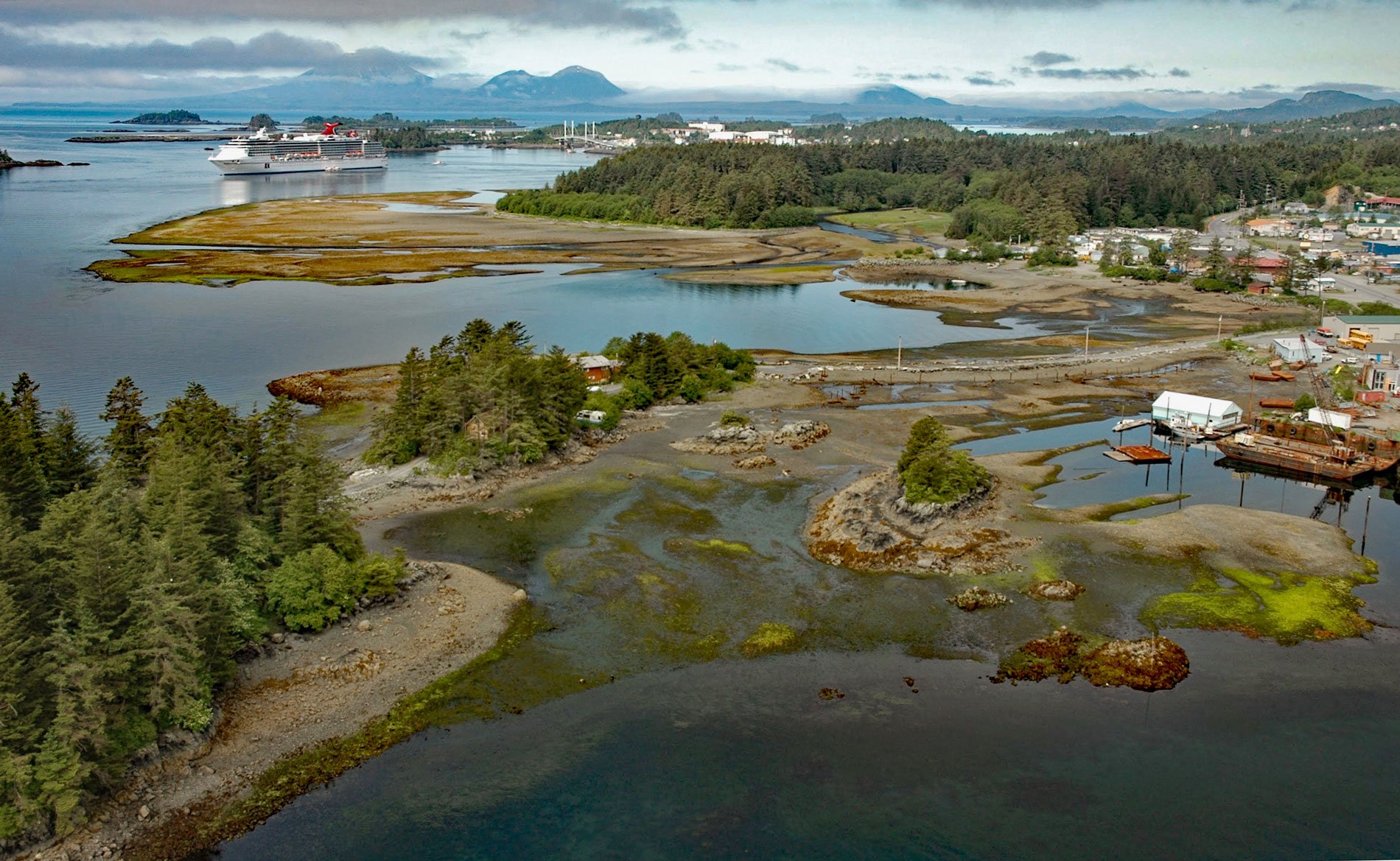Sitka is a community situated on Sitka Sound on the west coast of Baranof Island, about 185 miles (298 km) northwest of Ketchikan and 95 miles (153 km) southwest of Juneau, Alaska. In 1775, when competing European interests were searching the Pacific Northwest for economic opportunities, Spanish explorers Don Juan de la Bodega y Quadra, and Francisco Antonio Maurelle entered what is now Sitka Sound and named it “Ensenada del Susto” meaning “bay of terrors”. In 1787, British trader Captain George Dixon entered the sound and made a navigational sketch, calling it “Norfolk” for the Duke of Norfolk. In 1794, this name was adopted by Captain George Vancouver. The Russians, who began a settlement on the sound in 1799 gave it the name “Sitka Bay” for the site of a Tlingit village called “Shee Atika” meaning “by the sea”. The Tlingit name for Baranof Island is “Shi”. Baranof Island is about 105 miles (169 km) long and extends southeast from Peril Strait to Chatham Sound in the Alexander Archipelago of Southeast Alaska. It was named in 1805 by Captain Yuri Lysianskyi of the Imperial Russian Navy for Alexander Andreyevich Baranov who was the Chief Manager of the Shelikhov-Golikov Company that later became the Russian American Company.
Baranov had visited the island in 1795, in what he considered was Russian territory, and first observed foreigners conducting a very lucrative trade with the Tlingit people. He decided that British and American encroachment on Russia’s fur trade in the north Pacific required a permanent defensive fort in Southeast Alaska to maintain control of the region. Baranov negotiated with the local Tlingit people for a site on which the company could establish an outpost. Although Baranov preferred a more strategic location now called Castle Hill in Sitka, he was granted and paid a small sum for a site about 5.75 miles (9 km) to the north on Starrigavan Bay where the Russians established a trading post and fort, consisting of a few log buildings surrounded by a palisade, called Fort Arkhangela Mikhaila named after Archangel Michael. In 1802, after Baranov had returned to Kodiak, the administrative seat of Russian America, the Tlingit decided to expel the Russian settlers. The latter disregarded the warnings, and the Tlingit attacked and destroyed the fort, killing nearly everyone at the settlement. In 1804, Baranov returned and following the Battle of Sitka established a permanent presence at Castle Hill. The new fortification was named “Novoarkhangelsk” or “New Archangel”, and in 1808, the capital of Russian America was moved from Kodiak to New Archangel. The settlement became a major port on the north Pacific coast, with ships engaged in the maritime fur trade calling from many nations. Furs destined for European and Asian markets were the main export, but salmon, lumber, and ice were also exported to Hawaii, Mexico, and California. In 1856, Russia was going through economic and political turmoil after it lost the Crimean War to Britain, France, and the Ottoman Empire. Russia offered to sell Alaska to the United States, and Secretary of State William Seward negotiated the agreement to purchase Alaska. Sitka was the site of the transfer ceremony for the Alaska Purchase on October 18, 1867.
Sitka continued as the administrative headquarters for the Department of Alaska under the U.S. Army and General Jefferson C. Davis; however, by 1879, a federal customs collector was the only government authority based in Sitka. Russians and other settlers who had remained in Sitka after 1867 became alarmed at increasing signs of Tlingit hostility. When fighting erupted between Tlingits and settlers in February 1879, residents of Sitka called on the U.S. Navy to send a vessel for their protection. When there was no immediate reply, they appealed to the British who sent the HMS Osprey from Victoria to Sitka. The British ship was soon relieved by the USS Alaska, and in June 1879, the USS Jamestown under Commander Lester Beardslee arrived to begin a five-year period of U.S. Navy administration of Alaska. In 1878, the first salmon canneries were built at Klawock and Sitka and salmon fishing began a spectacular role in the fledgling Alaskan economy. During the early 1900s, the fishing industry brought in Filipino laborers for the salmon canneries. In 1906, the seat of government was relocated north to Juneau which had become economically more important with the Klondike Gold Rush. During World War II, Sitka was fortified and the U.S. Navy built an airbase on Japonski Island with 30,000 military personnel and over 7,000 civilians. After the war, the Bureau of Indian Affairs converted some of the buildings into a residential school for Alaska Natives, called Mount Edgecumbe High School. A large mill began operations at Silver Bay in 1960 to produce pulp from trees cut in the Tongass National Forest. At its peak, the mill employed around 450 people before closing in 1993. Japonski Island is now connected to Baranof Island by the John O’Connell Bridge and is home to the Sitka Airport, a branch campus of the University of Alaska Southeast, the Mount Edgecumbe Medical Center, the U.S. Coast Guard Air Station Sitka, and the U.S. Coast Guard Cutter Maple. Read more here and here. Explore more of Sitka and Baranof Island here:

